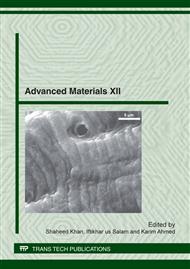[1]
F. K. Sautter, Electrodeposition of Dispersion-Hardened Nickel-Al2O3 Alloys, Journal of the Electrochemical Society, Volume 110, Issue 6, pp.557-560, the Electrochemical Society, Inc., (1963).
DOI: 10.1149/1.2425813
Google Scholar
[2]
P. K. Gupta, A. N. Tiwari and B. K. Agrawal, Electrodeposition and Mechanical Properties of Nickel-Tungsten Carbide Cermets, Transactions of the Japan Institute of Metal, Vol. 23, No. 6. (1982), pp.320-327, Elsevier Sequoia, (1989).
DOI: 10.2320/matertrans1960.23.320
Google Scholar
[3]
D. R. Gabe, Principle of Metal Surface Treatment and Protection, International Series on Materials Science an Technology, Volume 28. Second Edition, 1978, Pergamon International Library, (1978).
Google Scholar
[4]
Jaroslav Mackerle, Coatings and surface modification technologies: a finite element bibliography (1995–2005), Modelling Simulation in Materials Science and Engineering, Vol. 13 (2005) 935–979. Institute of Physics Publishing, (2005).
DOI: 10.1088/0965-0393/13/6/011
Google Scholar
[5]
N. Birks, G. H. Meier, F. S. Pettit, Introduction to the High-Temperature Oxidization, Second Edition, Cambridge University Press (2006).
Google Scholar
[6]
John M. West, Basic Corrosion and Oxidation, First Edition, Ellis Horwood Ltd., (1980).
Google Scholar
[7]
S. A. Bradford, Fundamental of Corrosion in Gases, ASM Handbook, Corrosion Volume 13, pp.62-76, 7th Print, ASM (2001).
Google Scholar
[8]
John Stringer, The Reactive Element Effect in High-temperature Corrosion, Material Science and Engineering A, Vol. 120 (1989), pp.129-137, Elsevier Sequoia, (1989).
DOI: 10.1016/0921-5093(89)90730-2
Google Scholar
[9]
Myong Jin Kim, Joung Soo Kim, Dong Jin Kim, and Hong Pyo Kim, Electro-Deposition of Oxide-Dispersed Nickel Composites and the Behavior of Their Mechanical Properties, Met. Mater. Int., Vol. 15, No. 5 (2009), p.789~795, Published 26 October (2009).
DOI: 10.1007/s12540-009-0789-2
Google Scholar
[10]
Kari Korpiola, High Temperature Oxidation of Metal, Alloy and Cermet Powders in HVOF Spraying Process, Doctoral Thesis (2004), Helsinki University of Technology Publications in Materials Science and Metallurgy, (2004).
Google Scholar
[11]
QiuyuanFeng, Tingju Li, HaitaoTeng, Xiaoli Zhang, Yu Zhang, Changsheng Liu, Junze Jin, Investigation on the corrosion and oxidation resistance of Ni–Al2O3 nano-composite coatings prepared by sediment co-deposition, Surface & Coatings Technology, Vol. 202, p.4137–4144, Elsevier, (2008).
DOI: 10.1016/j.surfcoat.2008.03.001
Google Scholar
[12]
Bogdan Szczygiel, Malgorzata Kolodziej, Composite Ni/Al2O3 coatings and their corrosion resistance, Electrochemica Acta , Vol. 50, p.4188–4195, Elsevier, (2005).
DOI: 10.1016/j.electacta.2005.01.040
Google Scholar
[13]
KR. Marikkannu, K. Amutha, G. Paruthimal Kalaignan, and T. Vasudevan. Studies on Nickel-Alumina Electrocomposite Coatings of Over Mild Steel Substrate, International Symposium of Research Students on Material Science and Engineering (ISSR), December 20-22, 2004, Chennai, India.
Google Scholar
[14]
I.G. Wright, V. Nagarajan and J. Stringer, Observations on Role of Oxide Scale in High-Temperature Erosion-Corrosion of Alloys, Oxidation of Metals, Vol. 25, Nos. 3/4, Plenum Publishing Corporation, (1986).
DOI: 10.1007/bf00655896
Google Scholar
[15]
L. M. Chang, J. H. Liu and R. J. Zhang, Corrosion behavior of electrodeposited Ni/Al2O3 composite coating covered with a NaCl salt film at 800 °C, Materials and Corrosion, 2010, No. 999 WILEY-VCH Verlag GmbH & Co. KGaA, Weinheim, (2010).
DOI: 10.1002/maco.200905617
Google Scholar
[16]
Pat Roche, In-Situ Combustion, New Technology Magazine, September (2009).
Google Scholar
[17]
M. E. Webber, J. Wang, S. T. Sanders, D. S. Baer and R. K. Hanson, In Situ Combustion Measurements of CO, CO2, H2O and Temperature Using Diode Laser Absorption Sensor, Proceedings of the Combustion Institute, Volume 28, p.407–413, (2000).
DOI: 10.1016/s0082-0784(00)80237-4
Google Scholar
[18]
L.M. Castanier, W.E. Brigham, Upgrading of crude oil via in situ combustion, Journal of Petroleum Science and Engineering , Vol. 39, p.125– 136, (2003).
DOI: 10.1016/s0920-4105(03)00044-5
Google Scholar
[19]
R. Gordon Moore, Catherine J. Laureshen, John D. M. Belgrave, Matthew G. Ursenbach and S. A. (Raj) Mehta, In situ combustion in Canadian heavy oil reservoirs, Fuel, Vol. 74, No. 8, pp.1169-1175, Elsevier Science Ltd. (1995).
DOI: 10.1016/0016-2361(95)00063-b
Google Scholar
[20]
Hai-Ying Helen Xu, In-Situ Upgrading of Heavy Oil, M. Sc. Thesis, University of Calgary, (2001).
Google Scholar
[21]
M. D. Debataraja, Kinetics of In-Situ Combustion, PhD thesis, Stanford University, (1993).
Google Scholar
[22]
R. K. Saha, I.U. Haq, T.I. Khan and L.B. Glenesk, Development of Wear Resistant Nano Dispersed Composite Coating by Electroplating, Key Engineering Material, Vol. 442, pp.187-194, Trans Tech Publication, Switzerland, (2010).
DOI: 10.4028/www.scientific.net/kem.442.187
Google Scholar
[23]
R. K. Saha, T.I. Khan, Effect of applied current on the electrodeposited Ni–Al2O3 composite coatings, Surface & Coatings Technology, Accepted in revised 8 August 2010, Available Online, Elsevier, (2010).
DOI: 10.1016/j.surfcoat.2010.08.035
Google Scholar
[24]
R. K. Saha, T.I. Khan and L.B. Glenesk and I.U. Haq, Formation of Electroplating Ni-Al2O3 Composite Coating, Processing of Nanoparticle Structures and Composites, Ceramic Transaction, Vol. 208, pp.37-44, The American Ceramic Society, Wiley, (2009).
DOI: 10.1002/9780470551523.ch5
Google Scholar
[25]
P. Baghery, M. Farzam, A.B. Mousavi, M. Hosseini, Ni–TiO2 nano-composite coating with high resistance to corrosion and wear, Surface & Coatings Technology, Vol. 204 (2010), p.3804–3810, Elsevier, (2010).
DOI: 10.1016/j.surfcoat.2010.04.061
Google Scholar
[26]
F. Erler, C. Jakob, H. Romanus, L. Spiess, B. Wielage, T. Lampke, S. Steinhauser, Interface behavior in nickel composite coatings with nano-particles of oxidic ceramic,. Electrochimica Acta , Vol. 48 (2003), pp.3063-3070. Pergamon, (2003).
DOI: 10.1016/s0013-4686(03)00380-3
Google Scholar
[27]
J.G. Chen. J.E. Crowell, J.T. Yates Jr., The Metal-Metal Oxide Interface: A Study of Thermally Activated Diffusion At The Ni/Al2O3 Interface Using Electron Spectroscopy, Surface Science, Vol. 185, pp.373-393, North-Holland, Amsterdam, (1987).
DOI: 10.1016/s0039-6028(87)80165-6
Google Scholar
[28]
D. F. Susan and A. R. Marder, Oxidation of Ni-Al-Base Electrodeposited Composite Coatings. I: Oxidation Kinetics and Morphology at 800ºC, Oxidation of Metals, Vol. 57, 131-158 (2002).
Google Scholar
[29]
D. F. Susan and A. R. Marder, Oxidation of Ni-Al-Base Electrodeposited Composite coatings. II: Oxidation Kinetics and Morphology at 1000ºC, Oxidation of Metals, Vol. 57, 159-180 (2002).
DOI: 10.1023/a:1013350914363
Google Scholar
[30]
Y.W. Yan, L. Geng and A.B. Li, Experimental and numerical studies of the effect of particle size on the deformation behavior of the metal matrix composites, Materials Science and Engineering A, Vol. 448, 315-325 (2007).
DOI: 10.1016/j.msea.2006.10.158
Google Scholar
[31]
CRC Materials Science and Engineering Handbook, pp.473-474. Third Edition, CRC Press, (2001).
Google Scholar


